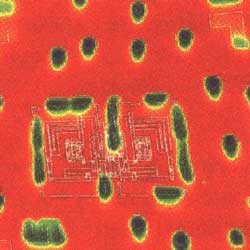A Very Tolerant Superconductor
The maximum magnetic field a superconductor can tolerate has just been doubled. In the 11 July PRL a team demonstrates that grinding a superconductor into nano-sized particles, then reforming it into a chunk of material, improved its magnetic tolerance. A commercially viable version of the technique could lead to more powerful magnets, which could be used for higher-resolution MRIs, better nuclear fusion reactors, and particle accelerators that whip particles to far higher energies than current magnets permit.
Most large magnets in research and clinical use are made from coils of superconducting wire. When cooled below their transition temperature, these materials have no electrical resistance and can maintain a magnetic field essentially forever. But there is a limit to the field strength you can generate with such a magnet because strong fields–above the so-called critical field–destroy its superconducting state.
Strong fields are harmful because superconductors ordinarily try to expel magnetic fields from their interiors, and their capacity to do so is limited. Many superconductors, however, reluctantly allow a medium-strength field to penetrate them by quarantining the field lines into long tubes called fluxons. In this state, the superconductor looks like Swiss cheese, with tubes of non-superconducting fluxons piercing it. As an external field is increased, the fluxons multiply and eat up more of the superconducting “cheese,” until, at the critical field, they choke off all pathways for superconducting current to flow. If the fluxons could be made skinnier, more of them could be added before the material fills up, which would raise the superconductor’s magnetic tolerance.
The girth of a fluxon is related to the distance an electron can travel in a straight line before scattering in a new direction. When superconducting electrons scatter more often, they reduce the “spreading” of the superconducting state into the normal fluxon cores, allowing a sharper boundary at the fluxon’s edge and shrinking its size. So Damian Hampshire and H. J. Niu of the University of Durham in the UK fabricated a material with lots of obstacles for electrons. Its structure has many grain boundaries, dislocations, and vacancies at the nanoscale. “It’s a bit like weaving through a forest,” says Hampshire. “There’s no freeway; if the trees are closer together, you bounce off them more often.”
The team created the material by milling into a powder with grains about 20 nanometers across. They pressed and heated this superfine powder to form pellets with a crystalline grain structure at the nanoscale. In the past, the technique was tried with Sn, but the heat treatment mutilated the nanocrystalline grain structure.
Nanocrystalline has a critical field close to 100 Tesla; a good commercial superconductor like Sn tolerates just 28 Tesla. Still, there would be immense practical difficulties using the Durham team’s method commercially, because the new material is brittle and almost impossible to draw into the fine wire needed for magnets, according to Paul Noonan of Oxford Instruments Superconductivity in the UK. “I can’t imagine a scheme for exploiting this process in the products we make–though that might say more about my imagination than the process!” he says. But he adds that having experimental validation that nanostructure manipulation works is encouraging. Hampshire points out that the new high temperature superconductors are also brittle, yet they have now been made into usable wires.
–Kim Krieger
Kim Krieger is a freelance science writer in Norwalk, Connecticut.



